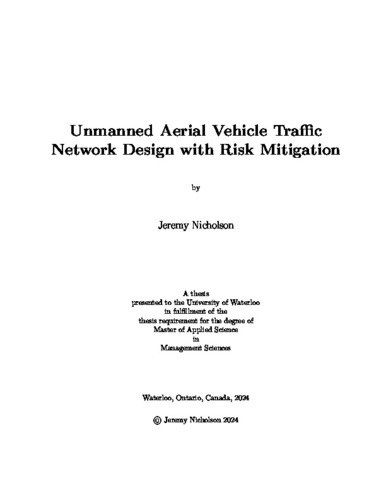| dc.contributor.author | Nicholson, Jeremy | |
| dc.date.accessioned | 2024-02-01 19:31:16 (GMT) | |
| dc.date.available | 2024-02-01 19:31:16 (GMT) | |
| dc.date.issued | 2024-02-01 | |
| dc.date.submitted | 2024-01-24 | |
| dc.identifier.uri | http://hdl.handle.net/10012/20328 | |
| dc.description.abstract | As unmanned aerial vehicle (UAV) technology becomes more robust and widespread,
more and more retail companies are seeing UAVs as a suitable alternative to ground-based transportation to deliver their packages. As a result, there has been an abundance
of OR research focused on UAV utilization for last-mile delivery. Due to the size and
mobility of UAVs, most of this research considers UAV movement within a shortest path or
Euclidean shortest path context. While this may be plausible if drone usage remains sparse,
this framework will not be possible as drone utilization ramps up to the levels required
to satisfy the levels of package demand expected in the coming decades. Furthermore,
none of this prior research (to our knowledge) suggests using risk inherent with UAV
travel to influence their proposals from a logistical and/or modelling perspective. As a
solution to this problem, our industry partner AirMatrix proposes that UAV travel be
restricted to transportation networks situated above the streets of population centres. We
propose a bi-objective network selection model for drone delivery which minimizes risk
while maximizing the amount of satisfied demand subject to budgetary constraints. We
discuss the factors that affect UAV risk and what metrics can be used to effectively reduce
those factors from a modelling perspective. We propose a two-stage stochastic variant of the
model and additional problem requirements to reflect practical operational requirements
and design goals. Using sample average approximation, we show that a deterministic
solution is effectively as good as an associated stochastic solution. We conduct testing on
a region of suburban Miami to evaluate how different risk objectives perform with respect
to network, path, arc, and performance metrics. | en |
| dc.language.iso | en | en |
| dc.publisher | University of Waterloo | en |
| dc.title | Unmanned Aerial Vehicle Traffic Network Design with Risk Mitigation | en |
| dc.type | Master Thesis | en |
| dc.pending | false | |
| uws-etd.degree.department | Management Sciences | en |
| uws-etd.degree.discipline | Management Sciences | en |
| uws-etd.degree.grantor | University of Waterloo | en |
| uws-etd.degree | Master of Applied Science | en |
| uws-etd.embargo.terms | 0 | en |
| uws.contributor.advisor | Gzara, Fatma | |
| uws.contributor.affiliation1 | Faculty of Engineering | en |
| uws.published.city | Waterloo | en |
| uws.published.country | Canada | en |
| uws.published.province | Ontario | en |
| uws.typeOfResource | Text | en |
| uws.peerReviewStatus | Unreviewed | en |
| uws.scholarLevel | Graduate | en |

